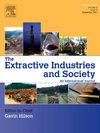Contested futures: Media, social cohesion, and the Kaunisvaara mine in Swedish public discourse 2006-2024
IF 4.3
2区 社会学
Q2 ENVIRONMENTAL STUDIES
Extractive Industries and Society-An International Journal
Pub Date : 2025-07-07
DOI:10.1016/j.exis.2025.101721
引用次数: 0
Abstract
This article examines how national and regional media discourses have constructed the Kaunisvaara iron mine in Pajala, northern Sweden, between 2006 and 2024. Through a critical discourse analysis of 57 articles from the national Dagens Nyheter (DN) and 872 from the regional Norrländska Socialdemokraten (NSD), the study traces six discursive phases that reflect shifting representations of industrial development, environmental responsibility, and territorial legitimacy. Drawing on Fairclough’s three-dimensional model, the analysis reveals how DN and NSD produced divergent yet overlapping narratives—shaped by editorial position, institutional scale, and regional proximity. DN’s coverage transitioned from developmental optimism to sustainability critique, while NSD consistently foregrounded local identity, economic hope, and regional pride, albeit sometimes at the expense of environmental or indigenous perspectives. Rather than treating media as neutral observers, the article emphasizes their role in shaping symbolic imaginaries and ideological framings of extractive futures. By situating the Kaunisvaara case within broader European debates on resource policy and rural transformation, the study shows how media discourses negotiate contested meanings of progress, justice, and belonging in the context of post-industrial peripheries.
有争议的未来:媒体、社会凝聚力和瑞典公共话语中的Kaunisvaara矿2006-2024
本文考察了2006年至2024年间,国家和地区媒体话语是如何构建瑞典北部帕加拉的Kaunisvaara铁矿的。通过对来自国家报纸《每日新闻》(DN)的57篇文章和来自地方报纸Norrländska《社会民主党人》(NSD)的872篇文章的批判性话语分析,该研究追溯了六个话语阶段,这些阶段反映了工业发展、环境责任和领土合法性的变化。利用费尔克劳的三维模型,分析揭示了DN和NSD如何产生不同但又重叠的叙事,这些叙事是由编辑立场、机构规模和区域邻近性决定的。DN的报道从对发展的乐观转向对可持续性的批评,而NSD一贯强调地方认同、经济希望和地区自豪感,尽管有时会牺牲环境或土著观点。这篇文章并没有将媒体视为中立的观察者,而是强调了媒体在塑造象征性想象和意识形态框架中所扮演的角色。通过将Kaunisvaara案例置于更广泛的欧洲关于资源政策和农村转型的辩论中,该研究展示了在后工业边缘背景下,媒体话语如何就进步、正义和归属感的争议意义进行谈判。
本文章由计算机程序翻译,如有差异,请以英文原文为准。
求助全文
约1分钟内获得全文
求助全文
来源期刊

Extractive Industries and Society-An International Journal
ENVIRONMENTAL STUDIES-
CiteScore
6.60
自引率
19.40%
发文量
135
 求助内容:
求助内容: 应助结果提醒方式:
应助结果提醒方式:


